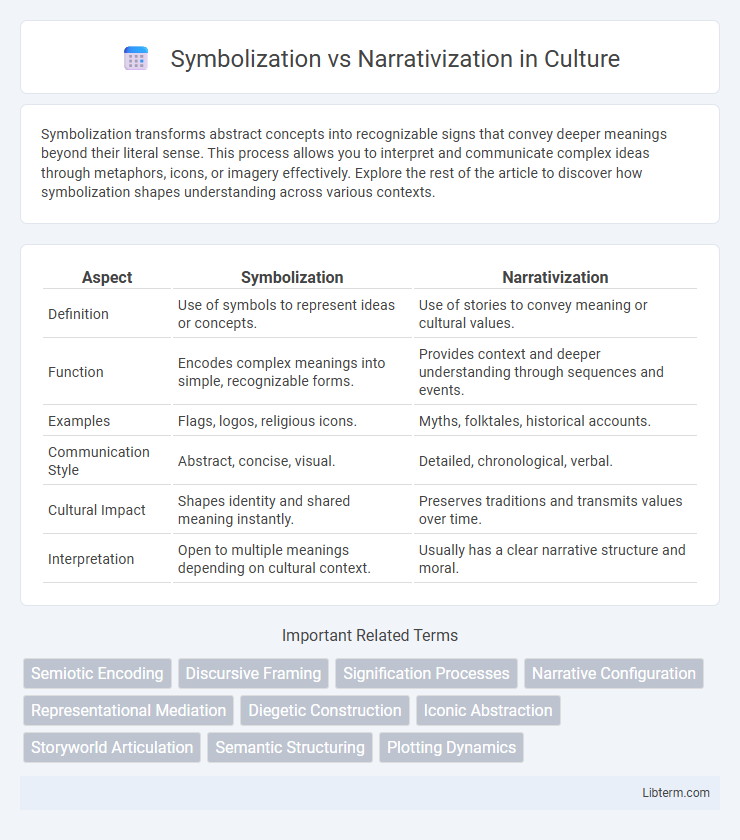Symbolization transforms abstract concepts into recognizable signs that convey deeper meanings beyond their literal sense. This process allows you to interpret and communicate complex ideas through metaphors, icons, or imagery effectively. Explore the rest of the article to discover how symbolization shapes understanding across various contexts.
Table of Comparison
| Aspect | Symbolization | Narrativization |
|---|---|---|
| Definition | Use of symbols to represent ideas or concepts. | Use of stories to convey meaning or cultural values. |
| Function | Encodes complex meanings into simple, recognizable forms. | Provides context and deeper understanding through sequences and events. |
| Examples | Flags, logos, religious icons. | Myths, folktales, historical accounts. |
| Communication Style | Abstract, concise, visual. | Detailed, chronological, verbal. |
| Cultural Impact | Shapes identity and shared meaning instantly. | Preserves traditions and transmits values over time. |
| Interpretation | Open to multiple meanings depending on cultural context. | Usually has a clear narrative structure and moral. |
Understanding Symbolization: Definition and Key Concepts
Symbolization involves the use of symbols to represent ideas, emotions, or complex concepts through culturally recognized signs, enabling abstract thinking and communication. Key concepts include the interpretation of symbols based on shared social norms, the role of semiotics in decoding meanings, and the cognitive processes that link symbolic representation to personal and collective understanding. Understanding symbolization is essential for analyzing language, art, and cultural expressions, as it reveals how meaning is constructed and conveyed beyond literal descriptions.
Narrativization Explained: Core Elements and Purpose
Narrativization involves structuring experiences or data into coherent stories that highlight causality, characters, and temporal sequences, enabling deeper understanding and meaning-making. Core elements include a clear plot, context-specific details, emotional engagement, and an identifiable perspective that connects events logically. The purpose of narrativization is to transform abstract information into relatable, memorable narratives that enhance interpretation, communication, and knowledge retention.
Symbolization vs Narrativization: Main Differences
Symbolization involves representing abstract ideas or concepts through symbols, icons, or visual signs that convey meaning succinctly, while narrativization entails structuring information or experiences into coherent stories with characters, plots, and sequences. Symbolization emphasizes concise, often non-linear communication through imagery or signs, whereas narrativization focuses on chronological or thematic unfolding of events to create understanding. The main difference lies in symbolization's reliance on symbolic representation versus narrativization's dependence on storytelling to engage and inform audiences.
Cognitive Processes Behind Symbolization and Narrativization
Symbolization involves encoding sensory experiences into abstract symbols, engaging neural circuits responsible for pattern recognition and memory consolidation. Narrativization organizes these symbols into coherent story structures, activating brain regions linked to sequential processing and theory of mind. Cognitive processes underlying symbolization emphasize categorization and representation, while narrativization relies on temporal sequencing and causal inference to construct meaningful narratives.
Applications in Literature and Art
Symbolization in literature and art uses symbols to evoke abstract ideas and emotions, enabling deeper interpretation beyond the literal narrative. Narrativization structures these symbols into coherent storylines, guiding audience understanding through sequential events and character development. Together, symbolization enriches thematic depth while narrativization provides context, enhancing engagement and meaning in creative works.
Impact on Memory and Meaning-Making
Symbolization enhances memory retention by condensing complex ideas into recognizable icons, facilitating quicker cognitive retrieval and deeper emotional resonance. Narrativization structures information into coherent stories, promoting better understanding and long-term recall by linking facts to meaningful sequences. Together, these processes influence meaning-making by transforming abstract concepts into relatable and memorable experiences.
Cultural Influences on Symbolization and Narrativization
Cultural influences shape symbolization by embedding shared meanings and values within symbols, making them powerful tools for group identity and communication. Narrativization reflects cultural context through storytelling traditions, structuring events and experiences into coherent narratives that convey moral lessons and collective memories. Both processes depend on cultural frameworks to interpret symbols and narratives, reinforcing social cohesion and cultural continuity.
Examples in Everyday Communication
Symbolization uses icons, signs, or images to convey meaning quickly, such as emojis representing emotions in text messages or logos signifying brand identity. Narrativization involves constructing stories to explain events or experiences, like sharing a detailed account of a trip to convey personal insights and emotions. Everyday communication blends these methods, for instance, using symbols like a heart emoji to complement a storytelling message about a meaningful relationship.
Symbolization and Narrativization in Media and Storytelling
Symbolization in media involves using symbols, icons, and imagery to convey complex ideas and emotions quickly, allowing audiences to interpret meanings beyond literal language. Narrativization structures these symbols into coherent stories that create emotional engagement and contextual depth, guiding how audiences understand events or concepts. Together, symbolization and narrativization shape media storytelling by blending visual metaphors with compelling narratives to enhance message retention and audience connection.
Implications for Education and Critical Thinking
Symbolization enhances abstract reasoning by enabling learners to represent complex ideas through symbols, fostering mental flexibility and cognitive precision. Narrativization promotes critical thinking by encouraging the construction of coherent stories, which aids in making sense of information, recognizing patterns, and understanding cause-effect relationships. Integrating both approaches in education cultivates balanced cognitive skills, enriching problem-solving abilities and deepening comprehension.
Symbolization Infographic

 libterm.com
libterm.com